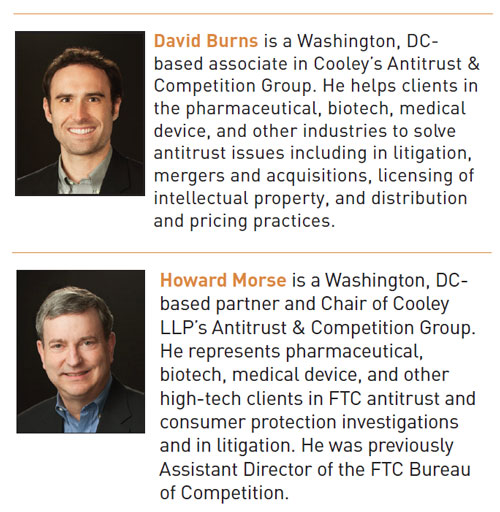
New Antitrust Risks from Introducing New Drugs
by David Burns and Howard Morse
Recent court decisions and statements by federal and state antitrust enforcers regarding “product hopping”— the practice of introducing a new version of an existing drug allegedly to discourage generic substitution—raise significant antitrust risks for pharmaceutical companies marketing new drugs.
New drugs, which can only be approved by the Food and Drug Administration (FDA) if safe and effective, typically bring considerable benefits to consumers. As a result, pharmaceutical companies may not instinctively think about antitrust risks when crafting product development strategies. In light of recent developments, however, firms are well-advised to keep this developing antitrust law on the radar.
In one high-profile case, the New York Attorney General filed suit and the Second Circuit last year, in New York v. Actavis, upheld an injunction against Actavis to prevent alleged illegal product hopping. Actavis had introduced an extended release version of an Alzheimer’s drug shortly before its patent expired on its immediate release formulation. The injunction required that Actavis continue to make the older version available until generics could enter, on the theory that withdrawing the older drug would have limited generic competition and constituted illegal monopolization.1
To some, the Second Circuit’s decision was an overreach of the antitrust laws, both because it compelled a company to continue to offer a legacy product to aid competitors, and seemingly faulted the company for developing and introducing an improved product. The Second Circuit reasoned, however, that while “neither product withdrawal nor product improvement alone is anticompetitive,” in this instance the combination “cross[ed] the line.”2
The Second Circuit’s endorsement of product hopping as an antitrust theory has encouraged others to challenge similar conduct. In September 2016, the attorneys general of 35 states and the District of Columbia filed suit against Indivior, alleging the firm delayed generic competition by withdrawing a tablet version of Suboxone, used to treat patients addicted to heroin and other drugs, to convert the market to a dissolvable oral strip or film version. The AGs also sued the company that licensed the film technology, alleging an illegal restraint of trade and conspiracy to monopolize as well as monopolization and attempted monopolization.
On September 28, 2016 the Third Circuit weighed in on alleged product hopping, or what it characterized as “insignificant modifications to a drug to keep generic competitors out of the market.” The Mylan v. Warner Chilcott court rejected plaintiff’s antitrust claims on the facts but did not “rule out the possibility” that “insignificant design or formula changes, combined with other coercive conduct” could present “a closer call” and establish liability in future cases.3
In this article, we distill key principles from this budding area of the law to help companies assess potential antitrust risks as they develop strategies for introducing new versions of existing drugs.
Legal Framework for Assessing Product Hopping
U.S. antitrust law prohibits both “agreements in restraint of trade” (Sherman Act § 1) and monopolization, attempts to monopolize and conspiracies to monopolize (Sherman Act § 2).
Congress did not intend the Sherman Act to “delineate the full meaning of the statute or its application in concrete situations.” The Supreme Court has explained that Congress, instead, expected courts “to give shape to the statute’s broad mandate.”4 Today’s understandings have been developed through common law case development over the last 100 years.
The Supreme Court, for instance, has recognized that “the legality of an agreement . . . cannot be determined by so simple a test, as whether it restrains competition [since e]very agreement concerning trade . . . restrains.”5 The Court has thus construed Section 1 to render unlawful only those restraints that unreasonably restrict competition.
The Supreme Court has also interpreted the offense of monopolization to require proof of both monopoly power and anticompetitive conduct, “[t]o safeguard the incentive to innovate.”6 Courts continue to struggle to define conduct that is “exclusionary,” applying such tests as whether the conduct “has impaired competition in an unnecessarily restrictive way” or whether the defendant “attempt[ed] to exclude rivals on some basis other than efficiency” or “elected forgo . . . short-run benefits because it was more interested in reducing competition.”7
Anticompetitive Product Hop—or Procompetitive Product Improvement?
Pharmaceutical companies typically have procompetitive reasons for researching, developing, and marketing new versions of existing drugs—whether based on a new delivery mechanism, different dosage, extended release, a combination with other drugs, reduced side-effects, longer shelf-life, or similar change. Their costly and risky efforts usually are of considerable value to patients, their care givers, and third-party payers—leading to drugs that are often safer, more effective, or easier to administer or take.
As a result, courts are “properly very skeptical about claims that competition has been harmed by a dominant firm’s product design changes,” which perversely risk condemning the very sort of procompetitive conduct the antitrust laws are intended to encourage.8
New versions of existing drugs can also benefit pharmaceutical companies by helping to grow or preserve revenues as patents on legacy products expire and they face the threat of generic competition. Pharmaceutical companies have understandable incentives to switch patients to newer, patent-protected products.
The antitrust risk from introducing a next-generation drug is smallest where (i) the drug offers potential benefits and (ii) doctors and pharmacists are able to choose between the new version of the drug and the legacy product, typically at a significantly discounted, post-generic entry price.
An illustrative decision is Walgreen Co. v. AstraZeneca. There, plaintiffs challenged AstraZeneca’s efforts to move patients from its $4 billion a year heartburn drug Prilosec to a new, patent-protected drug, Nexium. According to plaintiffs, Nexium was “virtually identical to and no more effective than Prilosec” and efforts to switch patients from Prilosec—such as aggressive promotion of Nexium—amounted to unlawful monopolization. While aggressively promoting Nexium, AstraZeneca did continue to sell Prilosec.9
AstraZeneca argued that by launching a new product, its conduct was procompetitive, and the court agreed, granting the company’s motion to dismiss for failure to state a claim. The court contrasted cases in which a defendant had eliminated consumer options by withdrawing the old drug, and found that in this instance AstraZeneca had instead “added choices. It introduced a new drug to compete with already-established drugs—both its own and others.’”10
The court rejected outright the theory that AstraZeneca violated antitrust law by transferring its “considerable sales efforts” to Nexium, finding that, short of “false representations or fraud,” a producer is entitled to “bathe its cause in the best light possible.” The court similarly rejected plaintiff’s theory that Nexium’s introduction anticompetitively “depressed” generic Prisolec sales, finding plaintiffs remained “free to compete with Prilosec” and the mere fact a new product “siphon[s] off” sales “does not create an antitrust cause of action.”11
AstraZeneca underscores that pharmaceutical companies are best positioned to fend off antitrust claims when their challenged conduct adds choices to the market, even where there may be questions as to whether the new product is actually an improvement.
Indeed, the AstraZeneca court emphatically rejected the plaintiff’s reliance on the alleged equivalence between Prilosec and Nexium, reasoning that nothing in antitrust law “requires a product new on the market . . . to be superior to existing products.” It explained: “Courts and juries are not tasked with determining which product among several is superior. Those determinations are left to the marketplace.”12
Another district case recently advised, “[a]lthough the issue of product-hopping is relatively novel, what is clear from the case law is that simply introducing a new product on the market, whether it is a superior product or not, does not, by itself, constitute exclusionary conduct.”13
Clear evidence that a new product offers no benefit, but was instead introduced for the sole purpose of switching customers to avoid competition, however, may give rise to antitrust risk.
An example of such an extreme case is CR Bard v. M3 Systems. There, M3 alleged Bard had modified a biopsy gun, a medical device used to extract body tissue, for the purpose of excluding rival manufacturers. Relying on the company’s internal documents indicating that the modifications “had no effect on gun or needle performance,” the court found that the “real reasons” for the modification were to increase the cost of entry and exclude rival suppliers. The court found this to constitute “restrictive or exclusionary conduct.”14
The Bounds of Permissible Product Hopping Conduct
Where the introduction of a new version of a drug is coupled with conduct that forces users to switch to that drug, antitrust risk increases.
At the far end of the spectrum is new product introduction combined with conduct that restricts the generic drug from even coming to market, so that customers have no choice but to switch.
The paradigmatic example of this sort of conduct was at play in Abbott v. Teva. There, plaintiffs alleged that after introducing a new formulation of its fenofibrate drug TriCor, which helps reduce cholesterol and triglycerides, the defendant not only stopped offering the legacy formulation, but also changed the National Drug Data File (NDDF) to obsolete. According to plaintiffs, this effectively blocked generic fenofibrate entry, thereby compelling consumers to switch to the new product and reducing consumer choice.15
The Second Circuit in New York v. Actavis found that restricting access to the legacy product before generic entry could be similarly condemned. The court reasoned that after switching to a new drug, patients rarely make the “reverse commute” back to generic offering (upon its entry) due to “high transaction costs,” such as obtaining a new prescription. The court thus concluded that defendant’s so-called “hard switch”—introducing an extended release product coupled with withdrawal of the immediate release version before generic entry—impermissibly risked permanent damage to competition in the generic market.16
Defenses to Product Hopping: Successful Strategies
There are good arguments why product hopping should not amount to a violation. Under U.S. antitrust law, “any firm, even a monopolist, may bring its products to market whenever and however it chooses” and there is no general “duty to aid competitors.”17 And patent owners are generally free to choose whether or not to practice a patent as well as to exclude others from infringing a valid patent.
Thus, so long as generics are able to enter and compete upon patent expiration, pharmaceutical companies arguably have no duty to aid generic competitors by facilitating free-riding through reliance on state drug substitution laws, which allow or require pharmacists to dispense AB-rated generic bioequivalent drugs to pioneer brand-name drugs. Nothing prevents generic firms, which are able to sell generic versions of previously marketed brand drugs, from promoting their drugs as good substitutes for newly introduced drugs, particularly in an era where managed care has increasing influence over prescribing practices of doctors.18
Proof of No Actual Exclusion
Defendants have been most successful defending antitrust claims where the evidence shows that generic competitors were not actually excluded by the product reformulation. In Mylan v. Warner Chilcott, for instance, the Third Circuit was faced with evidence suggesting that, at least in part “in an effort to transition the market” and “protect[] their name-brand franchise,” defendants had introduced reformulated versions of the acne drug Doryx and took steps to restrict sales of the legacy versions including destroying and buying back inventory.19
Nevertheless, the court was persuaded by evidence that despite the alleged exclusionary conduct Mylan was able to enter, earn “generous profits,” and for at least some time, charge a higher price than branded Doryx. The court found no evidence of “consumer coercion” and concluded that defendant’s “product modifications had no anticompetitive effects on the market.”20
The Ninth Circuit, in 2010, similarly rejected a claim that Tyco violated antitrust law by introducing a new pulse oximetry system that was incompatible with generic sensors, just as its legacy system was about to go off patent. Even though Tyco discontinued its legacy product, the generic entrants were able to enter the market, and took market share from Tyco.21
By contrast, in New York v. Actavis the Second Circuit found that the plaintiff was likely to prevail on its antitrust theory, even though generic entry could occur following patent expiration. The court reasoned that withdrawing the legacy drug from the market before generic entry was exclusionary because it was likely to “impede generic competition” by foreclosing reliance on state substitution laws, which the court deemed the “only cost-efficient means of competing available to generic manufacturers.”22
While a pro-defendant decision by the Third Circuit in Mylan could have set the stage for a circuit split prime for Supreme Court review, and the Mylan court did side with the defendants, it distinguished New York v. Actavis on the facts. The court relied on the absence of market power and evidence of actual generic entry, as well as the different procedural posture, leaving some room for plaintiffs to challenge product hopping in future cases.23
Notably, the Federal Trade Commission (FTC) argued in an amicus brief in Mylan for a standard that would condemn conduct that deprives rivals of their “most efficient distribution mechanisms . . . impeding . . . rivals’ competitive ability to discipline monopoly prices” or “damage[s] the market for the original formulation.”24
The extent to which pharmaceutical companies can engage in conduct designed to shift demand to a new drug before generic entry of the firm’s legacy drug is likely to remain a contested issue for the foreseeable future.
Room for Procompetitive Justifications
Both the Mylan and New York v. Actavis decisions employed a burden shifting framework for evaluating monopolization claims. Under that framework, the plaintiff bears the initial burden of establishing defendant’s conduct is anticompetitive or exclusionary. The defendant is then afforded the opportunity to come forward with non-pretextual, procompetitive justifications for its conduct. If it does, the plaintiff may rebut those justifications or demonstrate that the anticompetitive harm outweighs any procompetitive benefit.
In Mylan, the Third Circuit focused on the product redesign and found “strong evidence of non-pretextual purposes” for the changes, such as preventing esophageal problems and shelf-life stability problems.25
By contrast, in New York v. Actavis, the Second Circuit said it was “not significant” whether the new product was superior. Instead, the court considered whether the withdrawal of the legacy product was justified, and concluded the defendant’s proffered explanations were “pretextual” and that the real reason was to “put up barriers or obstacles” to generic competition.26
Practical Considerations to Avoid Antitrust Claims
Pharmaceutical companies introducing a new version of an existing drug should keep antitrust risks in mind when assessing product introduction and promotion strategies.
Conduct that prevents generic competition altogether is most likely to face antitrust scrutiny. But even without complete foreclosure, new product introduction coupled with withdrawal of a legacy drug—the so-called “hard switch” conduct condemned in New York v. Actavis—raises antitrust risk. Firms may argue that the introduction of a new product is procompetitive, and that there is no obligation to market a drug to assist generic competitors, but where courts will come out on such claims is far from certain.
Antitrust risks are also likely to be greatest when there is reason to believe the new product is not an improvement at all, at least if the legacy product is withdrawn in advance of generic entry. Pharmaceutical companies are therefore better positioned if they are able to highlight, both internally and in marketing documents, that the driver of the modification is the therapeutic benefit of the new drug rather than an effort to block generic competition.
Companies should be on firmer ground to engage in what the Second Circuit called a “soft switch,” promoting the new drug and not the old drug, or offering the new formulation at a discount, to encourage switching. A “soft switch,” however, may not be a “safe harbor” from antitrust challenge if the price of the legacy drug is increased or distribution restricted such that the exclusionary effect is similar to pulling the legacy product from the market.
The one thing that is certain is that with the FTC, state attorneys general, prospective generic competitors, and class action plaintiffs’ lawyers all attentive to product hopping conduct, there is likely to be more litigation in the coming years.
- New York ex rel. Schneiderman v. Actavis PLC, 787 F.3d 638 (2d Cir. 2015).
- Id. at 653-54.
- Mylan Pharms. Inc. v. Warner Chilcott PLC, No. 15-2236, 2016 WL 5404626, at *1, *12 (3d Cir. Sept. 28, 2016).
- National Soc’y of Prof’l Eng’rs v. United States, 435 U.S. 679, 688 (1978).
- Board of Trade of Chi. v. United States, 246 U.S. 231, 238 (1918).
- Verizon Communications Inc. v. Law Offices of Curtis V. Trinko, LLP, 540 U.S. 398, 407 (2004).
- Aspen Skiing Co. v. Aspen Highlands Skiing Corp., 472 U.S. 585, 605, 608 (1985).
- United States v. Microsoft Corp., 253 F.3d 34, 65 (D.C. Cir. 2001).
- Walgreen Co. v. AstraZeneca Pharms. L.P., 534 F. Supp. 2d 146, 148-51 (D.D.C. 2008).
- Id. at 151-53.
- Id. at 149, 151-52.
- Id. at 151-52.
- In re Suboxone Antitrust Litig., 64 F. Supp. 3d 665, 682 (E.D. Pa. 2014); Berkey Photo, Inc. v. Eastman Kodak Co., 603 F.2d 263, 287 (2d Cir. 1979) (“[N]o one can determine with any reasonable assurance whether one product is ‘superior’ to another. Preference is a matter of individual taste. The only question that can be answered is whether there is sufficient demand for a particular product to make its production worthwhile, and the response, so long as the free choice of consumers is preserved, can only be inferred from the reaction of the market.”).
- CR Bard v. M3 Systems, 157 F.3d 1340, 1382-83 (Fed. Cir. 1998).
- Abbott Laboratories v. Teva Pharmaceuticals USA, Inc., 432 F. Supp. 2d 408, 416, 423-24 (D. Del. 2006).
- New York v. Actavis, 787 F.3d at 656, 661.
- Trinko, 540 U.S. at 411; Berkey Photo, 603 F.2d at 286.
- See, e.g., Mylan Pharms. v. Warner Chilcott PLC, No. 12-3824, 2015 WL 1736957, at *13-14 (E.D. Pa. April 16, 2015) (“Mylan remains able to reach consumers through, inter alia, advertising, promotion, cost competition, or superior product development…. Spending some of its revenue on advertising would have lessened Mylan’s now-increased profits. Mylan chose not to do so, relying instead on the ‘promotion’ provided by state automatic substitution laws. Mylan is thus a ‘victim’ of its own business strategy, not Defendants’ ‘predatory’ conduct.”).
- Mylan, 2016 WL 5404626 at *3, *11 & n.80.
- Id. at *11-12 & n.18.
- Allied Orthopedic Appliances Inc. v. Tyco Health Care Group LP, 592 F.3d 991 (9th Cir. 2010).
- New York v. Actavis, 787 F.3d at 654-56. Product hopping can also complicate settlement of patent litigation. Actavis, for instance, is facing claims it settled patent litigation to delay generic entry until it could convert patients to its new extended release Alzheimer’s drug. It recently lost a motion to dismiss, even though the alleged reverse payment was no more than projected litigation costs and the agreement allowed for entry before patent expiration. The court noted that the plaintiffs alleged the settlements were “intentionally designed to keep competitors out of the market” until patients were converted to the new drug, which it considered “idiosyncratic enough” to “require discovery to determine whether the early-entry licenses were in fact anticompetitive.” Sergeants Benevolent Assoc. Health & Welfare Fund v. Actavis, PLC, Nos. 15-cv-6549 & 15-cv-7488, 2016 WL 4992690, at *15 (S.D.N.Y. Sept. 13, 2001).
- Mylan, 2016 WL 5404626 at *10-13.
- Brief for the FTC as Amicus Curiae, Mylan Pharms., Inc. v. Warner Chilcott PLC, No. 15-2236 (3d Cir. Sept. 30, 2015).
- Mylan, 2016 WL 5404626 at *11.
- New York v. Actavis, 787 F.3d at 653 n.25, 658-59.
Update Magazine
November/December 2016











